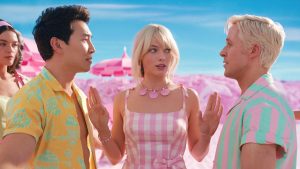I remember the moment I got my first Barbie. It was 1993, I was about to turn 4, and I was waking up from my third ear tube surgery. My reward for such bravery was a Bedtime Barbie whose eyes shifted from open to closed. She was dressed in a fuzzy pink nightgown with lace cuffs, matching slippers, with washcloth, toothbrush and plastic hairbrush included.
In the years that followed, my older brother and I would spend whole weekends building multi-level houses for my ever-expanding Barbie collection out of our equally impressive Lego collection. Eventually, “just Ken” was added to the group so my brother could have a boy that fit in our elaborate scenes.

Val Fisk
I am the target audience for Greta Gerwig’s instant hit, Barbie. After leaving the theater on Saturday evening, I immediately purchased a ticket for a show on Sunday afternoon. I expected to enjoy the movie. The cast is diverse and talented; the soundtrack is stacked with superstar artists; and Gerwig’s previous projects, Lady Bird (2017) and Little Women (2019), are two of the most moving female-centered films ever made.
However, I did not expect to shed more tears experiencing life through the eyes of Stereotypical Barbie than I did through the eyes of the March sisters. (Pack your tissues!)
My spoiler-free review: This movie is not only about the beauty and joy of childlike imagination. This movie is more than social commentary on the experience of being female in the real world.
Barbie is a movie about the human condition and what happens to all human beings when we are not given the freedom to appropriately and openly express emotion without shame. Barbie is a movie that reminds us that our imagination has no limits, but justice requires uncomfortable emotions and more imagination than we might allow ourselves.
Warning: Major spoilers ahead for plot of the movie. Read at your own risk!
The crux of the plot centers around Helen Mirren’s narration at the start of the movie: “Thanks to Barbie, all problems of feminism and equal rights have been solved — at least, that’s what the Barbies think.”
The movie then goes on to contrast the continued existence of patriarchy in the Real World against the supposed perfect equality of Barbieland. But the viewer is forced to ask, “Is Barbieland quite as perfect as it seems?”
Barbieland is a matriarchy. Barbies fill every role — construction worker, doctor, president, veterinarian. Even the Supreme Court is filled with Barbies. I will admit, watching the Barbies fill the whole Supreme Court infused me with a sense of pride.
In a 2015 event at Georgetown University, Justice Ruth Bader Ginsburg noted that when she was asked how many women are enough women on the Supreme Court, she answered, “Nine.” She went on to point out, “There had been nine men, and nobody’s ever raised a question about that.” I can’t help but think she would have loved this movie.
Ken is left to exist in Barbie’s shadow. “Barbie has a great day every day,” the narrator tells us. “Ken only has a great day if Barbie looks at him.”
“Barbie has a great day every day,” the narrator tells us. “Ken only has a great day if Barbie looks at him.”
When Gloria and Sasha make their way from the Real World into Barbieland, they point out that if all the Dream Houses belong to Barbies, where do the Kens stay? Barbie has no idea.
The fact is, although a Supreme Court filled with nine beautifully dressed and equality-minded women seems idyllic, they aren’t truly experiencing equality. I was surprised when the Barbies voted to restore their matriarchy as it was before Stereotypical Ken brought patriarchy to Barbieland. I truly expected that as we stared into the eyes of Stereotypical Barbie during that vote, she was about to spring up and suggest a more equal distribution of power between the Barbies, Kens, Allan, Midge, Skipper and Weird Barbie.
 Barbie’s hesitation to speak in that moment is an example of how difficult it is to voice our thoughts and feelings when we live in a world that does not invite us to dream quite that big. In a matriarchy, Ken is unable to express that he feels lost in the shadow, too focused on how he fits into Barbie’s life, while Barbie is only allowed fun, positive emotions. In our own Real World of patriarchy, Barbie feels the undertone of violence in the gaze of men around her, and Ken is encouraged to become part of that violent, oppressive undertone simply by existing. Again, they are both denied the full experience of emotion.
Barbie’s hesitation to speak in that moment is an example of how difficult it is to voice our thoughts and feelings when we live in a world that does not invite us to dream quite that big. In a matriarchy, Ken is unable to express that he feels lost in the shadow, too focused on how he fits into Barbie’s life, while Barbie is only allowed fun, positive emotions. In our own Real World of patriarchy, Barbie feels the undertone of violence in the gaze of men around her, and Ken is encouraged to become part of that violent, oppressive undertone simply by existing. Again, they are both denied the full experience of emotion.
In both the patriarchal and matriarchal societies of this movie, the needs and emotions of one gender are stifled for the sake of paying attention to the other. In both the Real World and Barbieland, the full emotional experience is discouraged and without it, imagination cannot grow enough to create equality.
There are definite gaps in the representation this movie provides. Yes, there is a wide and beautiful variety of Barbies, portrayed by women of every race and body type. But the Kens don’t get the representation of body type the Barbies get, all appearing conventionally attractive.
Despite being lauded for a cast that includes so many openly queer actors, the movie is rather heteronormative. Every Barbie has a perfectly matched Ken. Gloria and Sasha leave a stereotypically clueless dad home on the couch with his language-learning app. Earring Magic Ken and Allan, long rumored in the Barbie lore to be gay, were given no opportunity to offer the representation much of the LGBTQ community were hoping for in this movie.
When Stereotypical Barbie chooses to become human and to leave Barbieland, she knows there is more to life than what Barbieland can allow her. “I want to be part of the people that make meaning, not the thing that’s made. I want to do the imagining. I don’t want to be the idea.”
Sitting on a bus bench, experiencing the feelings in Gloria’s memories with Sasha; watching the people experiencing life around her, and then staring into the face of an elderly woman wearing a sparkly pink headband and sensible-but-cute orthotic wedges, Barbie sees there is beauty in living. Barbie sees the beauty that comes from choosing to make meaning, continuing to imagine what your future may hold, even when every day is not the best day ever.
Sitting on that bus bench, telling an elderly woman she is beautiful, hearing the woman respond, “I know it!” Barbie discovers that confidence and beauty are best developed through a life that embraces our changing selves, sharing those changes and the meaning we make from change.
And shouldn’t that be the goal for all of us?
On Sunday morning, our choir at University Baptist Church sang “A Place at the Table.”
For woman and man, a place at the table,
Revising the roles, deciding the share.
With wisdom and grace, dividing the power,
For woman and man, a system that’s fair.
God does indeed delight when we create justice, and justice in this world requires we give every person the freedom to appropriately and openly express emotion without shame. We create justice by imagining.
Ruth Handler told Barbie she was created without an ending because ideas have no end. God created us with an imagination that has no end.
“Being a human can be pretty uncomfortable. … Humans make things up like patriarchy and Barbie, just to deal with how uncomfortable it is.”
But humans are also capable of creating justice, if only we allow ourselves the imagination and the emotion required in that creative process.
Val Fisk serves as associate minister for students at University Baptist Church in Charlottesville, Va. She holds degrees from Judson University and Truett Seminary at Baylor University. In her spare time, Val provides editing services for self-publishing authors.


